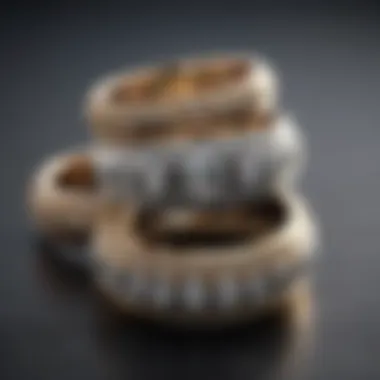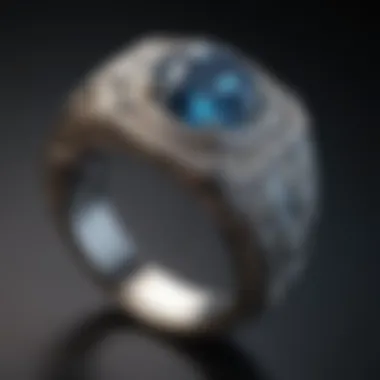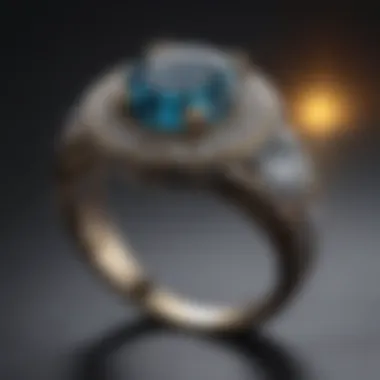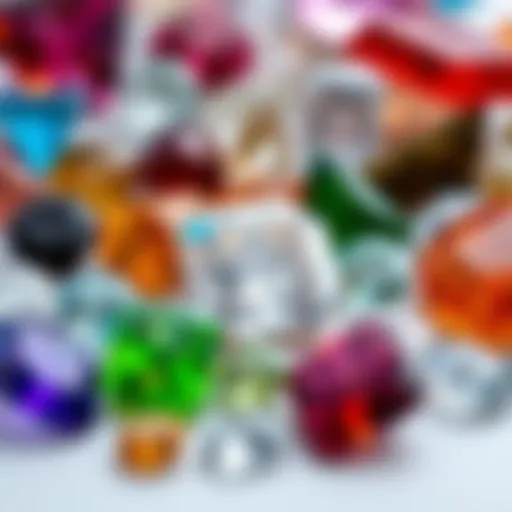Understanding Men's Engagement Rings and Wedding Bands


Intro
In recent years, the concept of men's engagement rings has seen a significant shift. Traditionally, engagement rings were predominantly a woman’s domain, but now men are stepping into the spotlight with their own unique styles. It raises the question of what really sets apart men's engagement rings from wedding bands. Both pieces represent a commitment, yet their purposes and styles can be remarkably different. This exploration aims to clarify these distinctions and encourages thoughtful consideration about each piece's significance.
Overview of Men's Engagement Rings and Wedding Bands
Understanding the realm of men's engagement rings versus wedding bands involves looking closely at their meanings and symbolism in modern romance.
- Engagement rings are typically given at the moment of proposal, symbolizing the promise of marriage.
- Wedding bands, on the other hand, are exchanged during the wedding ceremony, representing the vows made.
Both rings may serve to demonstrate love and commitment, but they do so in unique ways. As attitudes continue to evolve, so too does the appreciation for these symbols of love.
Styles and Materials: What to Consider
When choosing between an engagement ring and a wedding band, it’s essential to consider styles and materials.
Engagement Ring Styles
- Classic: Think of a single solitaire diamond; understated and elegant.
- Modern: Features like unique geometric shapes or alternative stones like sapphire can reflect personal taste.
- Vintage: These can be inspired by various eras like Art Deco or Edwardian.
Wedding Band Styles
- Simple: A plain metal band often symbolizes minimalism and elegance.
- Decorative: Bands adorned with engravings or small stones, offering a flair of individuality.
- Matching Sets: Some couples prefer to opt for complementary rings that match their engagement ring.
The materials also play a crucial role. Metals like platinum, gold, or titanium, each with unique characteristics, can greatly affect both the ring's look and its longevity. Knocking it out of the park involves choosing a material that resonates with both the individual and the relationship.
The Cultural Shift in Ring Choices
As society’s views shift, so has the way men express their commitment. The resounding voices of equality and personal choice echo in today’s discussions around engagement rings and wedding bands alike. For many, choosing an engagement ring is not just about tradition but a unique expression of personality.
More often than not, grooms are opting for designs that resonate with their styles and preferences. As such, the line between engagement and wedding rings is becoming increasingly blurred, leading to greater exploration in both realms.
"The evolution of men’s jewelry signifies a cultural moment where expression transcends tradition."
Concluding Thoughts
Navigating the landscape of men's engagement rings and wedding bands can be as intricate as the designs themselves. It’s about forging a narrative unique to the couple’s love story. As personal as the rings may be, every choice encompasses more than just aesthetics; it speaks volumes about commitment, culture, and personal expressions of love. Therefore, as you explore various options, keep in mind not just the trends but what resonates closely with your heart's message.
Defining the Concept of Commitment Symbols
In any discussion centered around men's engagement rings and wedding bands, understanding the role of commitment symbols is crucial. These pieces of jewelry are not just adornments, but rather powerful emblems of promises made—each telling a story of love, dedication, and partnership. A commitment symbol embodies the essence of two individuals coming together, signifying the transformation of a relationship into a formal union.
When we look at commitment symbols, it is important to consider their cultural significance, emotional weight, and inherent meanings. Rings have been used for centuries across various cultures as tokens of love and fidelity. Unlike other adornments, their circular shape symbolizes eternity, with no beginning or end—signifying a bond that is intended to last forever.
Cultural Significance of Rings
Throughout history, rings have held a significant place in romantic traditions. In many cultures, exchanging rings during engagements and weddings represents the social recognition of a couple's commitment. For example, in ancient Rome, it was customary for women to receive rings made from iron, which signified strength and endurance, while gold rings later became popular due to their lustrous appeal and durability.
In modern times, this ritual of exchanging rings has evolved. In Western cultures, engagement rings are typically adorned with diamonds, whereas wedding bands may feature simpler designs. Nevertheless, the underlying message remains unchanged: these rings symbolize a commitment to love and support each other through life's ups and downs.
Over time, as the status of marriage has evolved, so too has the cultural significance of rings—growing to encompass personal identities and styles. Nowadays, many couples see their rings as a reflection of their shared values, aesthetics, or even interests. This blend of tradition with individual expression makes the cultural context of rings an ever-evolving narrative.
Evolution of Jewelry in Romantic Relationships
The journey of jewelry in romantic relationships has been marked by dramatic changes over the centuries. Initially, pieces of jewelry were rather utilitarian—often fashioned from materials readily available in the environment, like shells, stones, or even bones. Fast forward to the middle ages, where ornately crafted rings began to emerge as symbols of power and status, transforming gradually into the engagement and wedding rings we know today.
Interestingly, the modern concept of the engagement ring as a prerequisite for marriage gained traction in the late 19th century. Prior to this, the idea was less formalized, but today it’s expected that the prospective groom presents a ring at the point of proposal. This marked a significant shift in societal norms and an acknowledgment of mutual commitment.
Furthermore, current trends reflect an increasing acceptance of diversity in meaning and representation within engagement jewelry. Individuals choose rings that resonate with their personal stories—be it through unique gemstones, alternative styles, or even non-traditional materials. When a couple selects their rings, they are articulating their individual experiences and love languages that transcend mere aesthetics.


"A ring is not just a piece of jewelry; it’s a narrative waiting to be told—a story of love, purpose, and a shared future."
Understanding these aspects prepares us for a deeper exploration of men's engagement rings and wedding bands, which will further enrich our appreciation for these profound tokens of commitment.
Understanding Men's Engagement Rings
In today's world, men's engagement rings have carved a unique niche within the broader framework of jewelry associated with commitment. Contrary to traditional views, these rings symbolize deep emotional connections, making them essential pieces in the dialogue of relationships. As couples explore their preferences, understanding the nuances of men's engagement rings becomes pivotal.
One of the significant benefits of exploring men's engagement rings is that they often hold a personalized context. For many, these rings go beyond mere decoration; they serve as a narrative of love stories and shared moments. Choosing an engagement ring offers an opportunity to reflect one’s identity and values, encapsulating a unique experience that can resonate with the wearer's personal journey.
Moreover, as society evolves, so do the expectations surrounding engagement rings for men. It's not just about the bling or the cost; many individuals are gravitating towards pieces that hold personal significance or that distinctly represent their relationships. As a result, the designs and materials used in men’s engagement rings are increasingly being considered. A clear understanding of these elements can end up influencing decisions profoundly.
Historical Context
Engagement rings for men aren't a new concept, though they may seem to be an emerging trend in contemporary jewelry. Historically, men's engagement rings were not as prevalent as women's. However, their roots can be traced back several centuries, when they symbolized ownership and commitment. This notion has significantly shifted in modern times, and the rings have transformed into symbols of mutual admiration rather than possessions alone.
The practice of gifting rings to signify engagement dates back to the Romans, who believed that a vein in the ring finger led directly to the heart. This belief provided a romantic basis for wearing rings and has formed the backbone of engagement customs. As cultures merged and evolved, so did their interpretations of engagement rings for men, but many traditional symbols remained integral.
Modern Trends
Today's society embraces diversified expressions of love, which extends to men's engagement rings. Fashion has taken the wheel, leading to varied styles, finishes, and materials that cater to individual preferences. Many men are opting for sleek designs that reflect both elegance and masculinity—considering textures like matte finishes or unique engravings that showcase their personalities.
Additionally, there is an escalating popularity of unconventional materials, such as titanium or even wood, that not only stand out but also resonate with the values of sustainability and uniqueness. This shift highlights a broader acceptance of personal identity in the selection process, where individuality is celebrated over traditional expectations.
Design Variations
When diving into the design aspects of men’s engagement rings, it's impossible to ignore the variety of choices available. Each piece can tell a story, incorporating elements that speak to the wearer's style and preferences.
Materials Used
One notable aspect of materials used in men’s engagement rings lies in their durability and modernity. For instance, materials like platinum and tungsten are becoming popular not just for their strength but also for their sleek appearance. Platinum, with its hypoallergenic properties, offers a timeless appeal while ensuring longevity—qualities that are invaluable for an engagement ring that’s often worn daily.
Another trending material is palladium, a metal that presents a lighter alternative to platinum while maintaining a similar aesthetic. The unique luster of palladium contributes to the contemporary appeal of male engagement rings, while simultaneously allowing customization options that cater to personal taste.
Stone Choices
Stone choices play a critical role in defining men’s engagement rings. While diamonds have long held the throne in the engagement ring realm, many are considering alternative stones. For example, sapphires and emeralds have garnered attention for their bold colors and unique charm. These stones not only add a personal touch but often also carry significance; sapphires represent loyalty, while emeralds symbolize rebirth.
Crucially, the uniqueness of the stone selection can reflect personal stories or shared experiences, creating an emotional attachment that transcends mere aesthetics. Plus, colored stones tend to be more cost-effective than traditional diamonds, making them an accessible choice for many couples today.
Setting Styles
Setting styles are another key aspect wherein creativity intertwines with tradition. The way a stone is set can greatly amplify its brilliance and overall appeal. Classic settings like solitaire provide a timeless look, but modern styles such as tension settings or bezel settings are increasingly preferred for their contemporary twist.
What's important here is the functionality and safety each style offers. For men who lead active lifestyles, a secure bezel setting can protect the stone from potential damage while providing an understated elegance. In contrast, a tension setting creates a prominent display, emphasizing the stone’s brilliance without compromising comfort.
Examining Wedding Bands for Men
When it comes to the symbolism of marital commitment, wedding bands for men hold a special place. These rings encapsulate a promise made to another person; their importance stretches across cultural, historical, and personal dimensions. The choice of a wedding band isn't just about aesthetics; it’s a long-term accessory carrying with it the weight of love, responsibility, and remembrance. Within this realm, several components warrant deeper exploration.
Traditional Perspectives
Traditionally, wedding bands for men have undergone various transformations, yet their core essence remains unchanged. In many cultures, they represent loyalty and unity. The simple gold band was often a symbol of wealth and status, so opting for the plain metal was a normal route, showcasing a man’s ability to provide. Over time, this viewpoint shifted with many embracing rings that reflect personality rather than mere societal expectations. These days, it’s not uncommon to spot men adorned with intricate designs, featuring patterns or engravings that resonate more personally.
Current Design Preferences
Fast-forward to modern times, and trends in men's wedding bands have seen an enhanced embrace of individuality. Men today often lean towards rings that stand out, perhaps featuring unique shapes or technological integrations such as smart rings. Trends also indicate a rise in mixed metals and carbon fiber bands, providing a sleeker look without sacrificing durability. The language of the ring is not just its physical appearance but how it speaks to a man’s identity. Thus, personal taste and fashion sense have become vital when selecting a band, leading to an expansive variety across the market.
Material Considerations
Deciding on the right material for a wedding band may feel like an uphill task considering the plethora of choices available. Let's break down the most noteworthy materials.


Classic Metals
When one mentions classic metals in the context of wedding bands, gold, platinum, and silver spring to mind. Gold remains a favorite due to its timeless appeal and malleability, which allows for various designs. Platinum is lauded for its weight and hypoallergenic properties; it’s durable yet soft enough to let artisans craft intricate designs. However, one should be mindful of the potential for scratching, especially with platinum.
Alternate Materials
Recently, alternate materials like tungsten and titanium have gained traction. Tungsten, known for its extreme hardness, is often chosen by men leading active lifestyles, though it can be heavier than traditional metals. Titanium is appreciated for its lightness and strength; plus, it works well for those with sensitive skin. On the flip side, both materials can pose challenges when it comes to resizing, unlike gold or platinum which can be adjusted with relative ease.
Customization Options
The ability to customize a wedding band has opened a world of opportunities for couples. Not only do customization options allow one to merge personal stories or shared experiences into the design, but they also create a ring that feels uniquely theirs. From etching initials to incorporating special stones, the sentiment behind a customized piece can elevate its meaning. Yet, be cautious; while customization lends uniqueness, it often reflects higher costs and may require longer production times, factors everyone should weigh carefully when making this significant choice.
"A wedding band is more than just a ring; it’s a physical reminder of one’s vows and shared journey."
Through understanding the historical context, modern trends, and materials regarding wedding bands for men, one can make an informed choice that balances tradition with personal expression. The significance of each selection extends far beyond its surface, allowing for a meaningful representation of commitment.
Comparing Engagement Rings and Wedding Bands
In today’s world, the significance of jewelry as a token of commitment has evolved quite a bit. Understanding the different yet interconnected roles that men's engagement rings and wedding bands play is imperative for anyone navigating through the journey of love and partnership. Both types of jewelry symbolize commitment, but they each hold unique purposes and features that cater to different sentiments and moments.
Purpose and Significance
Delving into the purpose of engagement rings versuss wedding bands opens a treasure chest of cultural insight. Engagement rings serve as the initial declaration of love and commitment, often gifted during the proposal. They signify a promise of future togetherness and enduring partnership. A well-chosen engagement ring with specifics reflecting the recipient’s style can create a lasting memory, while also making a statement about the couple's intentions towards each other.
Conversely, wedding bands represent a more profound declaration; they are exchanged during the marriage ceremony itself, underlining the bond that unions lovers — it’s not just about the individual but about the couple as a whole.
These rings serve to remind one another of the vows taken and the life built together. They’re a continual celebration of the relationship and symbolize an enduring commitment that has taken place post-ceremony. The wearing of these bands is more than aesthetic; it is a daily reminder of love and partnership in motion.
Design Contrast
When you look around, it's clear that engineered aesthetics play a major role in both engagement rings and wedding bands. Engagement rings often flaunt intricate designs that include a central stone, usually a diamond or other precious gem, held in place by an artistic setting. The creativity in design can be showcased in myriad ways: from the classic solitaire to elaborate vintage styles, the design often reflects the uniqueness of the relationship.
On the other hand, wedding bands lean more towards simplicity and elegance, focusing on a seamless design that complements the engagement ring. While they can feature diamonds or other design elements to varying degrees, wedding bands typically emphasize durability and function, as they will be worn daily. Whether forged from gold, platinum, or alternative materials like titanium or even wood, wedding bands exist in both subtle and bold designs, depending on the wearer’s preference.
Symbolism in Each Piece
In matters of symbolism, both rings carry different charges yet intersect along the same path. An engagement ring embodies the promise of marriage; they can be seen as a dreamcatcher where aspirations for the future are held together under one sparkling gem. This ring marks a pivotal point in a couple’s relationship, often infused with personal meaning — be it inheriting a family heirloom or choosing a specific design that reflects mutual interests.
Wedding bands, on their part, signify unity and eternity. Their circular form represents the infinite nature of love, with no beginning or end. Choosing the right kind of wedding band can reveal as much about the wearer’s character as an engagement ring can. Some might select matching sets to symbolize partnership while others may prefer distinct designs that speak to their individual identities. The deep layers of symbolic meaning enshrined in each piece encourage wearers to engage with their history and future together, ideally making informed choices based on personal values.
Escaping the mundane, these unique tokens of commitment encapsulate much more than just material value; they weave emotional narrative and personal stories into everyday life.
Whether you’re standing at the crossroads of choosing these exquisite pieces or reflecting on the emotional heft they carry, it's clear that men’s engagement rings and wedding bands each pulse with unique significance in the tapestry of love.
Personal Preferences and Choices
Choosing between men's engagement rings and wedding bands is not merely a matter of tradition; it’s a personal journey into one’s style and values. This section delves into the aspects that make personal preferences and choices pivotal in the selection process. Understanding what resonates with one's identity as well as aesthetic sense can lead to a decision that feels both right and satisfying. It is crucial because these choices speak volumes about personality, commitment, and future outlook.
Individual Style
Every individual possesses a unique style that acts as a reflection of their character and taste. When opting for an engagement ring or a wedding band, expressing personal style becomes a priority. Some men might lean towards understated simplicity, favoring a sleek, polished band in platinum. On the other end, a flashier piece, perhaps bedecked with intricate designs or stones, might resonate with others.
Creating an image that speaks to one’s individuality is essential. Think about the aesthetics that catch your eye—are you drawn to vintage styles or modern minimalism? For instance, a brushed finish may appeal to someone who likes a subtle, rugged look, while a high-polish finish could be fitting for those who appreciate a more refined elegance.
Comfort and Wearability
Comfort plays an often underrated role in the selection between engagement rings and wedding bands. It is critical that the chosen piece fits not only one’s style but also one’s lifestyle. A ring design with too many protruding stones might feel cumbersome during daily activities, whereas a smooth, rounded band might be ideal for someone with an active lifestyle. An improperly sized ring can lead to discomfort, and believe me, nothing is worse than dealing with that.
Moreover, consider the material in terms of comfort. For instance, titanium bands can be lighter and gentler on the skin compared to heavier gold options, minimizing potential irritation. Comfort is not just about fit but also about how the ring aligns with one’s daily routine.


Budget Considerations
While style and comfort are vital, budget considerations often influence the final decision. An individual's financial reality impacts the choices available, and it’s important to be practical without compromising on personal significance. It’s a balancing act; you don’t want to be left broke after choosing a ring.
Purchasing a piece that symbolizes commitment doesn't have to mean breaking the bank. There are plenty of beautiful, affordable options available. For example, opting for lab-grown diamonds or alternative stones, such as sapphires or moissanite, can provide a stunning appearance while keeping costs manageable.
Remember, the ring’s value isn’t solely determined by the price tag. Engaging in a more reasonable budget allows for flexibility and consideration of other important aspects post-purchase, such as maintenance or even potential future upgrades.
"Every ring tells a story, and it’s the personal journey that makes it invaluable."
In summary, personal preferences play a fundamental role when selecting between an engagement ring and a wedding band. Factors like individual style, comfort, and budget considerations blend together to create choices that embody personal narratives and values. Taking the time to deliberate on these factors ensures that the chosen piece will not only serve as a symbol of commitment but will also resonate deeply with the wearer.
The Role of Customization and Personalization
Customization and personalization play a pivotal role in modern jewelry, particularly when it comes to men’s engagement rings and wedding bands. As traditional symbols of commitment, these pieces carry profound significance, and customizing them allows individuals to express their unique identities and relationships. This personal touch not only enhances the aesthetic appeal but also deepens the emotional connection between the wearer and the piece.
The power of customization lies in its ability to transform a conventional piece of jewelry into a reflection of one’s journey or partnership. Here are some core elements to consider:
- Meaningful Designs: Tailoring designs to reflect personality traits, shared interests, or life experiences can transform a ring or band from being simply beautiful to being a cherished artifact.
- Unique Materials: Opting for less common materials, such as titanium, carbon fiber, or reclaimed wood, can make a piece stand out while also holding environmental significance.
- Engravings and Inscriptions: Adding personalized text, such as initials, dates, or meaningful phrases, is a time-honored way to imbue a piece with personal meaning.
A crucial consideration when embarking on the route of customization is to establish a balance between artistic expression and practical functionality. The piece should not only resonate on an emotional level but also be comfortable and durable in everyday wear.
Creating Unique Pieces
In an era where individuality is prized, the creation of unique pieces has become a significant trend among men's engagement rings and wedding bands. There’s a growing desire among couples for rings that stand apart from mass-produced options.
This process involves:
- Bespoke Design: Collaborating with a jeweler to design a completely unique piece ensures exclusivity. This could mean choosing a specific diamond cut or a combination of metals that epitomizes the couple's essence.
- Hybrid Styles: Some individuals opt for a fusion of styles, blending classic and contemporary elements. Think of a traditional band featuring modern accents or an engagement ring with an asymmetrical twist that shouts creativity.
- Innovative Stone Choices: Non-traditional gemstones are gaining traction. Instead of adhering strictly to diamonds, some explore options like sapphires, emeralds, or even intricate geodes that reflect personal stories and experiences.
Furthermore, customization also means paying attention to minute details like the band width or the texture finish, ensuring that every aspect feels just right.
Incorporating Personal Stories
The beauty of personalized jewelry lies in its capacity to embody stories and memories. Whether through the selection of particular stones or the choice of engraving, incorporating personal anecdotes transforms an ordinary piece into a compelling narrative.
- Symbolic Gemstone Choices: Using gemstones that represent significant moments, like the first vacation or an inside joke, can heavily personalize the ring. Imagine a couple choosing a vibrant citrine to symbolize sunshine in their partnership.
- Inscriptions with Meaning: Social media has allowed couples to craft short but poignant messages for engravings. Phrases or quotes that have sentimental value can turn the band into a lasting reminder of love and devotion.
- Family Heirlooms: Incorporating stones or materials from family pieces can create profound emotional ties, linking future generations to past ones. An engagement ring created from a grandmother's diamond can convey heritage and love across time.
Ultimately, the crux of customization is authenticity. The more a piece resonates with the couple's history and individuality, the more significant it becomes.
By embracing the role of customization and personalization in the selection of engagement rings and wedding bands, couples are crafting not just beautiful jewelry, but enduring reminders of their love and commitment.
Final Thoughts on Choosing Between Engagement Rings and Wedding Bands
Selecting between men’s engagement rings and wedding bands is no small feat. This decision carries weight, weaving together strands of personal taste, cultural expectations, and emotional significance. To navigate this journey, it's crucial to reflect on a few key elements that can guide you toward making a meaningful choice.
Balancing Tradition and Modernity
In today’s world, it’s not uncommon to see traditional values clash with modern sensibilities. Engagement rings have long been viewed as a symbol of commitment, often adorned with dazzling stones and intricate designs. However, some men might prefer more understated pieces or even opt for alternative materials like wood or titanium. Customization plays a pivotal role here. For example, an individual might take a classic design and put a modern twist on it, reflecting both heritage and contemporary flair.
- Tradition Remains Influential: Still, many lean into the old ways. A diamond, the classic engagement stone, holds its allure through generations.
- Modern Approaches: Others might choose colored gemstones not just for their aesthetic appeal but their uniqueness as well. A sapphire or emerald might resonate more personally with a couple's story.
Ultimately, finding that sweet spot between what has always been cherished and what feels fresh can lead to a choice that resonates on multiple levels.
The Importance of Meaningful Choices
When it comes to pieces of jewelry that symbolize commitment, the weight of choice is immense. Opting for either an engagement ring or a wedding band is more than a matter of style; it’s an act imbued with emotion.
Consider the implications of each choice. A wedding band often epitomizes enduring promise—the circle never ends. In contrast, an engagement ring might depict the emotion of the proposal itself, often carrying personal stories or shared moments.
Here are a few elements to ponder:
- Personal Stories: Engraving a date or initials inside a band can serve as a daily reminder of love’s journey.
- Value Beyond Material: The meaning attached to these pieces transforms what can seem like mere jewelry into powerful symbols.
"In many cultures, rings are not just jewelry; they are artifacts filled with meanings that go beyond mere appearance."
Choosing between engagement rings and wedding bands encapsulates a vital aspect of relationships themselves—consideration, emotion, and shared history.







